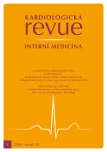Heart failure, cardiomyopathy and pregnancy
Authors:
Krejčí J.
Authors‘ workplace:
I. interní kardioangiologická klinika LF MU a FN u sv. Anny v Brně
Published in:
Kardiol Rev Int Med 2018, 20(4): 256-259
Overview
There are a number of haemodynamic changes during pregnancy and childbirth that may have a serious impact on women with the presence of heart failure, or lead to its manifestation in previously asymptomatic women. The diagnosis of heart failure during pregnancy may be complicated by the presence of concomitant difficulties associated with pregnancy that may hide the true cause of this condition. If heart failure is known already before pregnancy, our task is to participate in preconception counselling, maternal and foetal pregnancy risk assessment, medication adjustments during pregnancy, and discussion about optimal birth management. The most common cause of heart failure in pregnancy are cardiomyopathies. They do not form a homogeneous group of diseases, in some types of pregnancy it is well tolerated, while others are contraindications for a planned pregnancy or may be a reason for pregnancy interruption. Some cardiomyopathies are genetically linked and are associated with a possible transmission of disease to the child. To optimise care for women with heart failure who are planning a pregnancy or are already pregnant, it is desirable to create specialised multidisciplinary teams with participation of the cardiologist.
Key words:
heart failure – cardiomyopathy – pregnancy
Sources
1. Ponikowski P, Voors AA, Anker SD et al. 2016 ESC Guidelines for the diagnosis and treatment of acute and chronic heart failure: The Task Force for the diagnosis and treatment of acute and chronic heart failure of the European Society of Cardiology (ESC). Developed with the special contribution of the Heart Failure Association (HFA) of the ESC. Eur J Heart Fail 2016; 18(8): 891– 975. doi: 10.1002/ ejhf.592.
2. Roos-Hesselink JW, Duvekot JJ, Thorne SA. Pregnancy in high risk cardiac conditions. Heart 2009; 95(8): 680– 686. doi: 10.1136/ hrt.2008.148932.
3. Ng AT, Duan L, Win T et al. Maternal and fetal outcomes in pregnant women with heart failure. Heart 2018; pii: heartjnl-2018-313156. doi: 10.1136/ heartjnl-2018-313156.
4. Regitz-Zagrosek V, Roos-Hesselink JW, Bauersachs J et al. 2018 ESC Guidelines for the management of cardiovascular diseases during pregnancy. Eur Heart J 2018; 39(34): 3165– 3241. doi: 10.1093/ eurheartj/ ehy340.
5. Golia E, Gravino R, Rea A et al. Management of pregnancy in cardiomyopathies and heart failure. Future Cardiol 2017; 13(1): 81– 96. doi: 10.2217/ fca-2015-0004.
6. Elliott P, Andersson B, Arbustini E et al. Classification of the cardiomyopathies: a position statement from the European Society Of Cardiology Working Group on myocardial and pericardial diseases. Eur Heart J 2008; 29(2): 270– 276. doi: 10.1093/ eurheartj/ ehm342.
7. Krejčí J. Editorial. Proč bychom měli věnovat pozornost problematice kardiovaskulárních onemocnění v těhotenství? Kardiol Rev Int Med 2018; 20(4): 249– 250.
8. Grewal J, Siu SC, Ross H et al. Pregnancy outcomes in women with dilated cardiomyopathy. J Am Coll Cardiol 2009; 55(1): 45– 52. doi: 10.1016/ j.jacc.2009.08.036.
9. Stergiopoulos K, Shiang E, Bench T. Pregnancy in patients with pre-existing cardiomyopathies. J Am Coll Cardiol 2011; 58(4): 337– 350. doi: 10.1016/ j.jacc.2011.04.014.
10. van Tintelen JP, Pieper PG, Van Spaendonck-Zwarts KY et al. Pregnancy, cardiomyopathies, and genetics. Cardiovasc Res 2014; 101(4): 571– 578. doi: 10.1093/ cvr/ cvu014.
11. Schinkel AF. Pregnancy in women with hypertrophic cardiomyopathy. Cardiol Rev 2014; 22(5): 217– 222. doi: 10.1097/ CRD.0000000000000010.
12. Shin J, Kim M, Lee J et al. Pregnancy in hypertrophic cardiomyopathy with severe left ventricular outflow tract obstruction. J Cardiovasc Ultrasound 2016; 24(2): 158– 162. doi: 10.4250/ jcu.2016.24.2.158.
13. Elliott PM, Anastasakis A, Borger MA et al. 2014 ESC Guidelines on diagnosis and management of hypertrophic cardiomyopathy: the task force for the diagnosis and management of hypertrophic cardiomyopathy of the European Society of Cardiology (ESC). Eur Heart J 2014; 35(39): 2733– 2779. doi: 10.1093/ eurheartj/ ehu284.
14. Sliwa K, Hilfker-Kleiner D, Petrie MC et al. Current state of knowledge on aetiology, diagnosis, management, and therapy of peripartum cardiomyopathy: a position statement from the Heart Failure Association of the European Society of Cardiology Working Group on peripartum cardiomyopathy. Eur J Heart Fail 2010; 12(8): 767– 778. doi: 10.1093/ eurjhf/ hfq120.
15. Bozkurt B, Colvin M, Cook J et al. Current diagnostic and treatment strategies for specific dilated cardiomyopathies: a scientific statement from the American Heart Association. Circulation 2016; 134(23): e579– e646. doi: 10.1161/ CIR.0000000000000455.
16. Calkins H, Corrado D, Marcus F. Risk stratification in arrhythmogenic right ventricular cardiomyopathy. Circulation 2017; 136(21): 2068– 2082. doi: 10.1161/ CIRCULATIONAHA.117.030792.
17. Iriyama T, Kamei Y, Kozuma S et al. Management of patient with arrhythmogenic right ventricular cardiomyopathy during pregnancy. J Obstet Gynaecol Res 2013; 39(1): 390– 394. doi: 10.1111/ j.1447-0756.2012.01954.x.
18. Bush N, Nelson-Piercy C, Spark P et al. Myocardial infarction in pregnancy and postpartum in the UK. Eur J Prev Cardiol 2013; 20(1): 12– 20. doi: 10.1177/ 1741826711432117.
19. Elkayam U, Jalnapurkar S, Barakkat MN et al. Pregnancy-associated acute myocardial infarction: A review of contemporary experience in 150 cases between 2006 and 2011. Circulation 2014; 129(16): 1695– 1702. doi: 10.1161/ CIRCU-LATIONAHA.113.002054.
Labels
Paediatric cardiology Internal medicine Cardiac surgery CardiologyArticle was published in
Cardiology Review

2018 Issue 4
Most read in this issue
- Hypertension in pregnancy
- Heart rhythm disorders in pregnancy
- Diagnosis and management of angioedema
- The ankle-brachial index in diabetes - what is the most appropriate measurement method?
